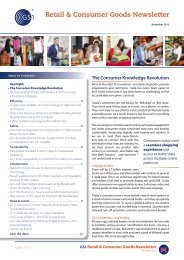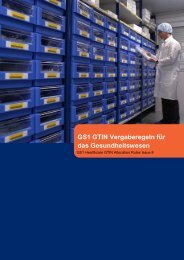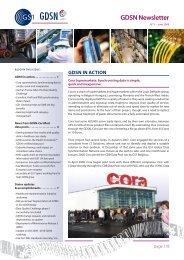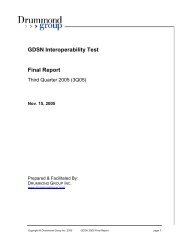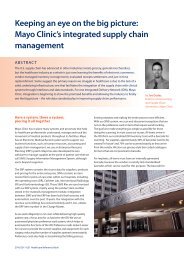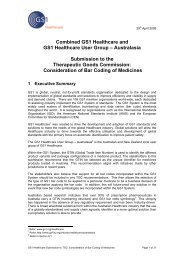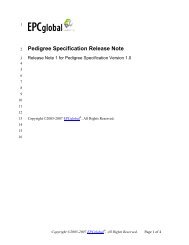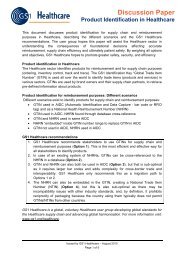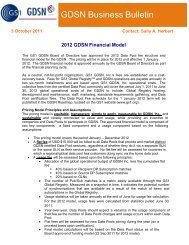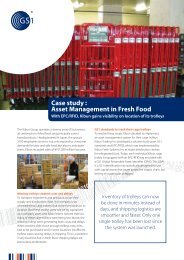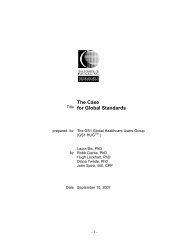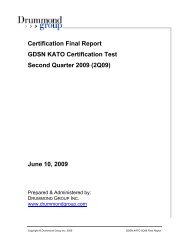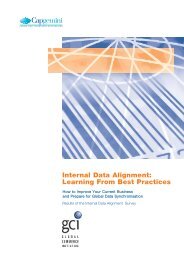The Application Level Events (ALE) Specification, Version 1.0 - GS1
The Application Level Events (ALE) Specification, Version 1.0 - GS1
The Application Level Events (ALE) Specification, Version 1.0 - GS1
Create successful ePaper yourself
Turn your PDF publications into a flip-book with our unique Google optimized e-Paper software.
2780<br />
2781<br />
2782<br />
2783<br />
2784<br />
2785<br />
2786<br />
2787<br />
2788<br />
2789<br />
2790<br />
2791<br />
2792<br />
2793<br />
2794<br />
2795<br />
2796<br />
2797<br />
2798<br />
2799<br />
2800<br />
2801<br />
2802<br />
2803<br />
2804<br />
2805<br />
2806<br />
2807<br />
2808<br />
2809<br />
2810<br />
2811<br />
2812<br />
2813<br />
4. ECFilterSpec includePatterns includes the EPC(s) illustrated in<br />
this scenario.<br />
13.2.3.2 Description<br />
1. <strong>The</strong> <strong>ALE</strong> client calls the define method of the <strong>ALE</strong> interface. <strong>The</strong><br />
ECSpec contains a valid duration as the boundary specification – though<br />
any valid boundary conditions could be specified. <strong>The</strong> ECReportSpec and<br />
ECFilterSpec contained within the ECSpec are defined to include the<br />
EPC data sent later in steps 3 and 4. At this point the ECSpec is considered<br />
“Unrequested.”<br />
2. <strong>The</strong> <strong>ALE</strong> client calls the poll method of the <strong>ALE</strong> interface, naming the<br />
ECSpec previously defined in Step 1. At this point the ECSpec is<br />
transitioned to the “Active” state, and the event cycle begins for the duration<br />
specified in the ECSpec. During the duration of the event cycle the <strong>ALE</strong><br />
client is blocked waiting for a response to the poll method.<br />
3. An EPC which meets the filter conditions of the ECSpec is received during<br />
the event cycle. At the end of the event cycle, the ECReports is generated<br />
and returned to the <strong>ALE</strong> client as the response to the poll method. At this<br />
point the ECSpec transitions to the “Unrequested” state.<br />
4. An EPC that meets the filter conditions of the ECSpec is reported to the <strong>ALE</strong><br />
layer, but since there is no “Active” ECSpec, this EPC will not be reported.<br />
5. <strong>The</strong> <strong>ALE</strong> client invokes the poll method of the <strong>ALE</strong> interface a second time.<br />
This is similar to the process described above in Steps 2 and 3, but since no<br />
EPC is received, no EPC data is returned in the ECReports.<br />
6. Later, the <strong>ALE</strong> client calls the immediate method of the <strong>ALE</strong> interface.<br />
This is very similar to the use of poll, except that when the client calls<br />
immediate it provides the ECSpec as part of the method call, as opposed<br />
to referring to a previously defined ECSpec. Since a new ECSpec is<br />
provided with the immediate method, it can contain any valid combination<br />
of parameters and report options.<br />
14 Glossary (non-normative)<br />
This section provides a non-normative summary of terms used within this specification.<br />
For normative definitions of these terms, please consult the relevant sections of the<br />
document.<br />
Term Section Meaning<br />
<strong>ALE</strong><br />
(<strong>Application</strong><br />
<strong>Level</strong> <strong>Events</strong>)<br />
Interface<br />
1 Software interface through which <strong>ALE</strong> Clients may obtain<br />
filtered, consolidated EPC data from a variety of sources.<br />
Copyright © 2005, 2004 EPCglobal Inc, All Rights Reserved. Page 69 of 71



